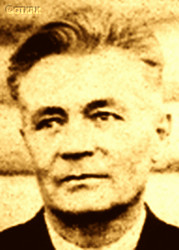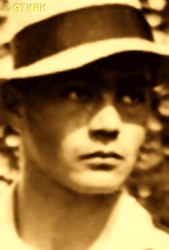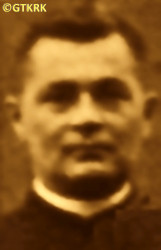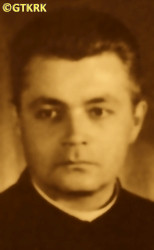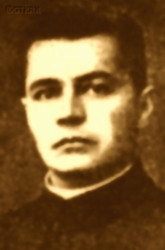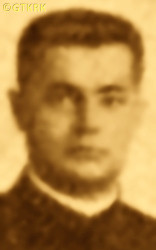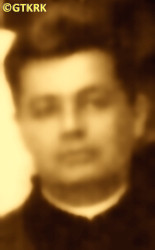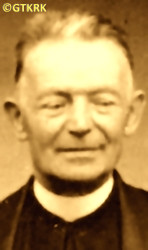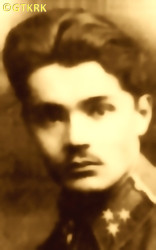Roman Catholic
St Sigismund parish
05-507 Słomczyn
85 Wiślana Str.
Konstancin deanery
Warsaw archdiocese, Poland
full list:
displayClick to display full list

searchClick to search full list by categories
wyświetlKliknij by wyświetlić pełną listę po polsku

szukajKliknij by przeszukać listę wg kategorii po polsku

Martyrology of the clergy — Poland
XX century (1914 – 1989)
personal data
religious status
Servant of God
surname
WENHRYNOWICZ
forename(s)
Stephen Emilian (pl. Szczepan Emilian)
forename(s)
versions/aliases
Stephen Omelian (pl. Stepan Omelian)

function
eparchial priest
creed
Ukrainian Greek Catholic GCmore on
en.wikipedia.org
[access: 2013.05.19]
diocese / province
Apostolic GC Exarchate of Lemkowszczyznamore on
en.wikipedia.org
[access: 2024.03.02]
Przemyśl GC eparchymore on
pl.wikipedia.org
[access: 2013.05.19]
nationality
Ukrainian
date and place
of death
19.06.1954

Dzhonkatoday: Nanaysky reg., Khabarovsk Krai, Russia
more on
ru.wikipedia.org
[access: 2024.03.19]
details of death
After the end of World War I, during Polish–Ukrainian war of 1918‐1919, from 11.1918, soldier of the Ukrainian Galician Army HA — artillery gunner prob. at 7th Infantry Brigade.
Interned by Polish authorities in Stryi (captured by Polish troops on 20.05.1919) or, according to other sources, in Stanislaviv (the Poles recaptured that city on 25.05.1919).
During transport to an internment camp in the interior of Poland — probably to OJiI No 1 Dąbie camp near Kraków — escaped from a running train n. Żurawica village n. Przemyśl.
After German and Russian invasion of Poland in 09.1939 and start of the World War II, lived in Sanok, on the left bank of San river, under German occupation (Sanok on the right bank of San from 1939 was occupied by the Russians).
Supported Ukrainian National Council in Sank, collaborating with Germans.
Yet after German attack on 22.06.1941 of their erstwhile ally, Russians, arrested on 14.09.1941 by the Germans.
Till mid 10.1941 held in Sanok jail.
From 05.1943 chaplain to the Ukrainian genocidal Germ. 14. Waffen–Grenadier–Division der SS (galizische SS‐Division Nr. 1), Eng. 14. Waffen–Grenadier–Division of the SS (Galician SS‐Division Nr. 1), collaborating with and fighting alongside Germans.
After German defeat and start in 1944 of another Russian occupation deported in 01.1946 from Sanok (then in Russian–run Polish republic prl) — during arrest beaten on 20.01.1946 by Polish Commie‐Nazi soldiers — to Sambir (in Russian occupied Ukraine).
Refused to convert to Russian Orthodoxy.
Thus after formal dissolution of Greek Catholic Church by the Russians (on 08‐10.03.1946 during so‐called Lviv pseudo–council) and its incorporation into Russian Orthodox Church worked as a janitor in local historical Sambir museum (1946‐1950).
At the same time however clandestinely ministered to Greek Catholic faithful.
On 27.03.1950 arrested by the Russian MGB (successor to the genocidal NKVD), together with his wife.
For „nationalist activity” and „support of illegal Greek Catholic Church against Orthodox Church” sentenced on 22.04.1950 for deportation.
On 04.06.1950 transported to Khabarovsk Krai in Siberia in Russia.
There slaved as a carpenter, but secretly ministering to faithful deportees.
There perished from heart attack.
cause of death
extermination
perpetrators
Russians
sites and events
Forced exileClick to display the description, GulagClick to display the description, «Genocidium Atrox»Click to display the description, GeneralgouvernementClick to display the description, Ribbentrop‐MolotovClick to display the description, Pius XI's encyclicalsClick to display the description, OJiI No. 1 DąbieClick to display the description, Polish‐Ukrainian war of 1918‐1919Click to display the description
date and place
of birth
07.04.1897

Chyrzynkatoday: part of Chyrzyna village, Krzywcza gm., Przemyśl pov., Subcarpathia voiv., Poland
more on
en.wikipedia.org
[access: 2021.12.18]
alt. dates and places
of birth
08.01.1897
parents
WENHRYNOWICZ Vladimir
🞲 1867, Dźwiniacz Dolnytoday: Ustrzyki Dolne gm., Bieszczady pov., Subcarpathia voiv., Poland
more on
en.wikipedia.org
[access: 2025.02.11] — 🕆 1947, Vanovychitoday: Staryi Sambir urban hrom., Sambir rai., Lviv obl., Ukraine
more on
uk.wikipedia.org
[access: 2025.02.11]

SZAFRAŃSKA Sophia
🞲 ?, ? — 🕆 1915, ?
presbyter (holy orders)
ordination
16.10.1921

Przemyśltoday: Przemyśl city pov., Subcarpathia voiv., Poland
more on
en.wikipedia.org
[access: 2021.04.01]
St Therese GC cathedral churchmore on
en.wikipedia.org
[access: 2025.03.14]
positions held
1946 – 1950
priest — Sambirtoday: Sambir urban hrom., Sambir rai., Lviv obl., Ukraine
more on
en.wikipedia.org
[access: 2021.02.12] ⋄ Greek Catholic Church (clandestine)
03.1945 – 1946
membership — chapter i.e. council ⋄ Lemkowszczyzna GC Apostolic Exarchate
1943 – 1946
pro‐synodal judge — Apostolic Exarchate Court ⋄ Lemkowszczyzna GC Apostolic Exarchate
05.1943 – c. 1944
RC military chaplain — Germ. 14. Waffen–Grenadier–Division der SS (galizische SS‐Division Nr. 1), Eng. 14. Waffen–Grenadier–Division of the SS (Galician SS‐Division No 1) (known as SS‐Galizien), Germ. Waffen‐SS, i.e. Eng. Armed SS
1942 – 1946
membership — Consistory (i.e. Curia) ⋄ Lemkowszczyzna GC Apostolic Exarchate
1927 – 1946
prefect — Sanoktoday: Sanok urban gm., Sanok pov., Subcarpathia voiv., Poland
more on
en.wikipedia.org
[access: 2021.10.09] ⋄ St Kinga Primary School (c. 1936‐1939), Emily Plater Private Co‐educational Merchant Gymnasium of the Polish Teachers' Union (c. 1934‐1939), Queen Sophie State Gymnasium for Boys (c. 1933‐1939), Gregory of Sanok Primary School (c. 1934‐1939), Clementine Hoffmanowa Primary School (c. 1936‐1939), Thaddeus Kościuszko Primary School (c. 1934‐1939), Queen Hedwig 7‐grade Primary School for Girls (c. 1928‐1939), King Vladislav Jagiełło 7‐grade Primary School for Boys (c. 1928‐1939), Municipal Private Teachers' Seminary for Women (c. 1932) ⋄ Holy Trinity GC parish ⋄ Sanoktoday: Sanok urban gm., Sanok pov., Subcarpathia voiv., Poland
more on
en.wikipedia.org
[access: 2021.10.09] GC deanery
1928 – 1939
deputy director — Sanoktoday: Sanok urban gm., Sanok pov., Subcarpathia voiv., Poland
more on
en.wikipedia.org
[access: 2021.10.09] ⋄ „Lemkivshchyna” Museum — also: co‐founder
chairman — Sanoktoday: Sanok urban gm., Sanok pov., Subcarpathia voiv., Poland
more on
en.wikipedia.org
[access: 2021.10.09] ⋄ „Narodnyj Dim” Ukrainian cultural and educational institution — also: board member
1921 – 1927
prefect — Drohobychtoday: Drohobych urban hrom., Drohobych rai., Lviv obl., Ukraine
more on
en.wikipedia.org
[access: 2021.10.09] ⋄ Ivan Franko's Gymnasium ⋄ Holy Trinity GC parish ⋄ Drohobychtoday: Drohobych urban hrom., Drohobych rai., Lviv obl., Ukraine
more on
en.wikipedia.org
[access: 2021.10.09] GC deanery — also: teacher
1920 – 1921
teacher — Drohobychtoday: Drohobych urban hrom., Drohobych rai., Lviv obl., Ukraine
more on
en.wikipedia.org
[access: 2021.10.09] ⋄ Ivan Franko's Gymnasium
1920
student — Przemyśltoday: Przemyśl city pov., Subcarpathia voiv., Poland
more on
en.wikipedia.org
[access: 2021.04.01] ⋄ philosophy and theology, Greek Catholic Theological Seminary
c. 1919 – c. 1920
soldier — Ukrainian Galician Army UHA
1915 – 1918
student — Lvivtoday: Lviv urban hrom., Lviv rai., Lviv obl., Ukraine
more on
en.wikipedia.org
[access: 2022.01.16] ⋄ philosophy and theology, Greek Catholic Theological Seminary
married — two children
others related
in death
ANDREJCZUKClick to display biography Peter, DIAKClick to display biography Basil, DOBRZAŃSKIClick to display biography Nicholas, HAJDIUKClick to display biography Michael, HAJDIUKClick to display biography Michael, HOŁOWACZClick to display biography Nicholas, HORECZKOClick to display biography Michael, LESZCZUKClick to display biography Joseph, KOSTYSZYNClick to display biography Vladimir, LISKIEWICZClick to display biography Nicholas, ŁEMCIOClick to display biography Vladimir, NIMYŁOWICZClick to display biography Demetrius, SZAŁASZClick to display biography Steven, SZCZERBAClick to display biography Yaroslav, SZEWCZUKClick to display biography Basil, SZUMIŁOClick to display biography Rostislav, WEŁYCZKOClick to display biography Michael, WENHRYNOWICZClick to display biography Orestes, WENHRYNOWICZClick to display biography Vladimir, ZAWOROTIUKClick to display biography Michael, KRILClick to display biography Michael, NICZAJClick to display biography Stephen, WOROBIJClick to display biography Michael
sites and events
descriptions
Forced exile: One of the standard Russian forms of repression. The prisoners were usually taken to a small village in the middle of nowhere — somewhere in Siberia, in far north or far east — dropped out of the train carriage or a cart, left out without means of subsistence or place to live. (more on: en.wikipedia.orgClick to attempt to display webpage
[access: 2014.12.20])
Gulag: The acronym Gulag comes from the Rus. Главное управление исправительно‐трудовых лагерей и колоний (Eng. Main Board of Correctional Labor Camps). The network of Russian concentration camps for slave labor was formally established by the decision of the highest Russian authorities on 27.06.1929. Control was taken over by the OGPU, the predecessor of the genocidal NKVD (from 1934) and the MGB (from 1946). Individual gulags (camps) were often established in remote, sparsely populated areas, where industrial or transport facilities important for the Russian state were built. They were modeled on the first „great construction of communism”, the White Sea‐Baltic Canal (1931‐1932), and Naftali Frenkel, of Jewish origin, is considered the creator of the system of using forced slave labor within the Gulag. He went down in history as the author of the principle „We have to squeeze everything out of the prisoner in the first three months — then nothing is there for us”. He was to be the creator, according to Alexander Solzhenitsyn, of the so‐called „Boiler system”, i.e. the dependence of food rations on working out a certain percentage of the norm. The term ZEK — prisoner — i.e. Rus. заключенный‐каналоармец (Eng. canal soldier) — was coined in the ITL BelBaltLag managed by him, and was adopted to mean a prisoner in Russian slave labor camps. Up to 12 mln prisoners were held in Gulag camps at one time, i.e. c. 5% of Russia's population. In his book „The Gulag Archipelago”, Solzhenitsyn estimated that c. 60 mln people were killed in the Gulag until 1956. Formally dissolved on 20.01.1960. (more on: en.wikipedia.orgClick to attempt to display webpage
[access: 2024.04.08])
«Genocidium Atrox»: In 1939‐1947, especially in 1943‐1944, independent Ukrainian units, mainly belonging to genocidal Ukrainian organizations OUN (political arm) and UPA (military arm), supported by local Ukrainian population, murdered — often in extremely brutal way — in Volyn and surrounding regions of pre‐war Poland, from 130,000 to 180,000 Poles, all civilians: men, women, children, old and young. Polish‐Ukrainian conflict that openly emerged during and after World War I (in particular resulting in Polish‐Ukrainian war of 1918‐1919), that survived and even deepened later when western Ukraine became a part Poland, exploded again after the outbreak of the World War II in 09.1939. During Russian occupation of 1939‐1941, when hundreds of thousands of Poles were deported into central Russia, when tens of thousands were murdered (during so‐called Katyń massacres, among others), this open conflict had a limited character, helped by the fact that at that time Ukrainians, Ukrainian nationalists in particular, were also persecuted by the Russians. The worst came after German‐Russian war started on 22.06.1941 and German occupation resulted. Initially Ukrainians supported Germans (Ukrainian police was initiated, Ukrainians co—participated in extermination of the Jews and were joining army units fighting alongside Germans). Later when German ambivalent position towards Ukraine became apparent Ukrainians started acting independently. And in 1943 one of the units of aforementioned Ukrainian OUN/UPA organization, in Volyn, started and perpetrated a genocide of Polish population of this region. In mere few weeks OUN/UPA murdered, with Germans passively watching on the sidelines, more than 40,000 Poles. This strategy was consequently approved and adopted by all OUN/UPA organisations and similar genocides took place in Eastern Lesser Poland (part of Ukraine) where more than 20,000 Poles were slaughtered, meeting however with growing resistance from Polish population. Further west, in Chełm, Rzeszów, etc. regions this genocide turned into an extremely bloody conflict. In general genocide, perpetrated by Ukrainian nationalists, partly collaborating with German occupants, on vulnerable Polish population took part in hundreds of villages and small towns, where virtually all Polish inhabitants were wiped out. More than 200 priests, religious and nuns perished in this holocaust — known as «Genocidium Atrox» (Eng. „savage genocide”) The nature and purpose of genocide is perhaps best reflected in the song sung by the murderers: „We will slaughter the Poles, we will cut down the Jews, we must conquer the great Ukraine” (ukr. „Поляків виріжем, Євреїв видусим, велику Україну здобути мусим”). This holocaust and conflict ended up in total elimination of Polish population and Polish culture from Ukraine, in enforced deportations in 1944‐1945 of remaining Poles from Ukraine and some Ukrainians into Ukraine proper, and finally in deportation of Ukrainians from East‐South to the Western parts of Polish republic prl by Commie‐Nazi Russian controlled Polish security forces („Vistula Action”). (more on: www.swzygmunt.knc.plClick to attempt to display webpage
[access: 2021.06.20])
Generalgouvernement: After the Polish defeat in the 09.1939 campaign, which was the result of the Ribbentrop‐Molotov Pact and constituted the first stage of World War II, and the beginning of German occupation in part of Poland (in the other, eastern part of Poland, the Russian occupation began), the Germans divided the occupied Polish territory into five main regions. In two of them new German provinces were created, two other were incorporated into other provinces. However, the fifth part was treated separately, and in a political sense it was supposed to recreate the German idea from 1915 (during World War I, after the defeat of the Russians in the Battle of Gorlice in 05.1915) of creating a Polish enclave within Germany. Illegal in the sense of international law, i.e. Hague Convention, and public law, managed by the Germans according to separate laws — especially established for the Polish Germ. Untermenschen (Eng. subhumans) — till the Russian offensive in 1945 it constituted part of the Germ. Großdeutschland (Eng. Greater Germany). Till 31.07.1940 formally called Germ. Generalgouvernement für die besetzten polnischen Gebiete (Eng. General Government for the occupied Polish lands) — later simply Germ. Generalgouvernement (Eng. General Governorate), as in the years 1915‐1918. From 07.1941, i.e. after the German attack on 22.06.1941 against the erstwhile ally, the Russians, it also included the Galicia district, i.e. the Polish pre‐war south‐eastern voivodeships. A special criminal law was enacted and applied to Poles and Jews, allowing for the arbitrary administration of the death penalty regardless of the age of the „perpetrator”, and sanctioning the use of collective responsibility. After the end of the military conflict of the World War UU, the government of the Germ. Generalgouvernement was recognized as a criminal organization, and its leader, governor Hans Frank, guilty of war crimes and crimes against humanity and executed. (more on: en.wikipedia.orgClick to attempt to display webpage
[access: 2024.12.13])
Ribbentrop‐Molotov: Genocidal Russian‐German alliance pact between Russian leader Joseph Stalin and German leader Adolf Hitler signed on 23.08.1939 in Moscow by respective foreign ministers, Mr. Vyacheslav Molotov for Russia and Joachim von Ribbentrop for Germany. The pact sanctioned and was the direct cause of joint Russian and German invasion of Poland and the outbreak of the World War II in 09.1939. In a political sense, the pact was an attempt to restore the status quo ante before 1914, with one exception, namely the „commercial” exchange of the so‐called „Kingdom of Poland”, which in 1914 was part of the Russian Empire, fore Eastern Galicia (today's western Ukraine), in 1914 belonging to the Austro‐Hungarian Empire. Galicia, including Lviv, was to be taken over by the Russians, the „Kingdom of Poland” — under the name of the General Governorate — Germany. The resultant „war was one of the greatest calamities and dramas of humanity in history, for two atheistic and anti‐Christian ideologies — national and international socialism — rejected God and His fifth Decalogue commandment: Thou shall not kill!” (Abp Stanislav Gądecki, 01.09.2019). The decisions taken — backed up by the betrayal of the formal allies of Poland, France and Germany, which on 12.09.1939, at a joint conference in Abbeville, decided not to provide aid to attacked Poland and not to take military action against Germany (a clear breach of treaty obligations with Poland) — were on 28.09.1939 slightly altered and made more precise when a treaty on „German‐Russian boundaries and friendship” was agreed by the same murderous signatories. One of its findings was establishment of spheres of influence in Central and Eastern Europe and in consequence IV partition of Poland. In one of its secret annexes agreed, that: „the Signatories will not tolerate on its respective territories any Polish propaganda that affects the territory of the other Side. On their respective territories they will suppress all such propaganda and inform each other of the measures taken to accomplish it”. The agreements resulted in a series of meeting between two genocidal organization representing both sides — German Gestapo and Russian NKVD when coordination of efforts to exterminate Polish intelligentsia and Polish leading classes (in Germany called «Intelligenzaktion», in Russia took the form of Katyń massacres) where discussed. Resulted in deaths of hundreds of thousands of Polish intelligentsia, including thousands of priests presented here, and tens of millions of ordinary people,. The results of this Russian‐German pact lasted till 1989 and are still in evidence even today. (more on: en.wikipedia.orgClick to attempt to display webpage
[access: 2015.09.30])
Pius XI's encyclicals: Facing the creation of two totalitarian systems in Europe, which seemed to compete with each other, though there were more similarities than contradictions between them, Pope Pius XI issued in 03.1937 (within 5 days) two encyclicals. In the „Mit brennender Sorge” (Eng. „With Burning Concern”) published on 14.03.1938, condemned the national socialism prevailing in Germany. The Pope wrote: „Whoever, following the old Germanic‐pre‐Christian beliefs, puts various impersonal fate in the place of a personal God, denies the wisdom of God and Providence […], whoever exalts earthly values: race or nation, or state, or state system, representatives of state power or other fundamental values of human society, […] and makes them the highest standard of all values, including religious ones, and idolizes them, this one […] is far from true faith in God and from a worldview corresponding to such faith”. On 19.03.1937, published „Divini Redemptoris” (Eng. „Divine Redeemer”), in which criticized Russian communism, dialectical materialism and the class struggle theory. The Pope wrote: „Communism deprives man of freedom, and therefore the spiritual basis of all life norms. It deprives the human person of all his dignity and any moral support with which he could resist the onslaught of blind passions […] This is the new gospel that Bolshevik and godless communism preaches as a message of salvation and redemption of humanity”… Pius XI demanded that the established human law be subjected to the natural law of God , recommended the implementation of the ideal of a Christian state and society, and called on Catholics to resist. Two years later, National Socialist Germany and Communist Russia came together and started World War II. (more on: www.vatican.vaClick to attempt to display webpage
[access: 2023.05.28], www.vatican.vaClick to attempt to display webpage
[access: 2023.05.28])
OJiI No. 1 Dąbie: POWs and Internees Camp No. 1, in the Kraków district of Dąbie — one of the internment camps, during the Polish–Ukrainian war of 1918‐1919, the Polish–Czech conflict of 1919 and the Polish–Russian war of 1919‐1921 — for prisoners captured by the Polish Army, i.e. Ukrainians, Czechs, Russians. Established in 11.1918 on the site of a POW camp of the former Austro–Hungarian Empire. At its peak, in 03.1920, the camp held 4,987 people. Epidemics of typhus and dysentery broke out in the camp several times: e.g. in 12.1918, 02.1919. During the three years of the camp's existence, 1,104 people died there. Liquidated on 06.12.1921. (more on: dabiehistoria.blogspot.comClick to attempt to display webpage
[access: 2025.03.07])
Polish‐Ukrainian war of 1918‐1919: One of the wars for borders of the newly reborn Poland. At the end of 1918 on the former Austro‐Hungarian empire’s territory, based on the Ukrainian military units of the former Austro‐Hungarian army, Ukrainians waged war against Poland. In particular attempted to create foundation of an independent state and attacked Lviv. Thanks to heroic stance of Lviv inhabitants, in particular young generation of Poles — called since then Lviv eaglets — the city was recaptured by Poles and for a number of months successfully defended against furious Ukrainian attacks. In 1919 Poland — its newly created army — pushed Ukrainian forces far to the east and south, regaining control over its territory. (more on: en.wikipedia.orgClick to attempt to display webpage
[access: 2017.05.20])
sources
personal:
pl.wikipedia.orgClick to attempt to display webpage
[access: 2014.03.21], newsaints.faithweb.comClick to attempt to display webpage
[access: 2014.03.21], localhistory.org.uaClick to attempt to display webpage
[access: 2025.03.09], magazine.lds.lviv.uaClick to attempt to display webpage
[access: 2014.03.21]
bibliographical:
„Clergy of Przemyśl Eparchy and Apostolic Exarchate of Lemkivshchyna”, Bogdan Prach, Ukrainian Catholic University Publishing House, Lviv 2015
original images:
www.vox-populi.com.uaClick to attempt to display webpage
[access: 2015.03.01], localhistory.org.uaClick to attempt to display webpage
[access: 2025.03.09], commons.wikimedia.orgClick to attempt to display webpage
[access: 2020.04.04], newsaints.faithweb.comClick to attempt to display webpage
[access: 2014.03.21], commons.wikimedia.orgClick to attempt to display webpage
[access: 2020.04.04], localhistory.org.uaClick to attempt to display webpage
[access: 2025.03.09], localhistory.org.uaClick to attempt to display webpage
[access: 2025.03.09], dds.edu.uaClick to attempt to display webpage
[access: 2016.03.14]
LETTER to CUSTODIAN/ADMINISTRATOR
If you have an Email client on your communicator/computer — such as Mozilla Thunderbird, Windows Mail or Microsoft Outlook, described at WikipediaPatrz:
en.wikipedia.org, among others — try the link below, please:
LETTER to CUSTODIAN/ADMINISTRATORClick and try to call your own Email client
If however you do not run such a client or the above link is not active please send an email to the Custodian/Administrator using your account — in your customary email/correspondence engine — at the following address:

giving the following as the subject:
MARTYROLOGY: WENHRYNOWICZ Stephen Emilian
To return to the biography press below:
 Click to return to biography
Click to return to biography








